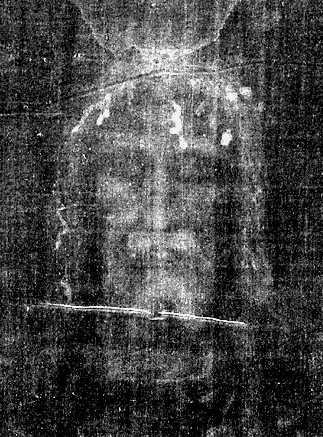 “He was crucified under Pontius Pilate…”
“He was crucified under Pontius Pilate…”We pray these words of the creed so glibly that their meaning often escapes us. They state that Jesus – God’s eternal Son who became one of us – died like a common criminal. Since God cannot suffer, God the Son took on our mortal nature so that he could suffer. The one who suffers is a person (“My tooth is killing me”). Since there is only one person in Jesus of Nazareth – a divine person – it means that he, God, experienced excruciating pain. Utilizing the Shroud of Turin, I would like us to consider just how excruciating that pain was.
The Shroud of Turin
The Holy Shroud is a 14-foot linen cloth with the frontal and dorsal image of a nude man who appears to have been physically traumatized by crucifixion. It is kept in the royal chapel of the Cathedral in Turin, Italy. Composed of faint shades of brown, the image is barely visible to the naked eye.
The existence of the shroud can be historically traced to France, where it was in the possession of Geoffroi de Charney in the year 1357. The Knights Templar allegedly came into possession of the shroud in the sack of Constantinople during the Fourth Crusade. Prior to that, it was identified with the Image of Edessa, dating back to the fourth century. John’s gospel refers to the burial cloths of Jesus, which Peter and John discovered on entering the tomb on Easter morning.
In 1898, Secondo Pia, an amateur photographer, was allowed to photograph the shroud for the first time as part of a rare exhibit in the Turin Cathedral. Later, developing the negative in his darkroom, he almost dropped the photographic glass plate – so shocked was he to see the image of a face on it. His negative was in fact a “positive” image of the brown shadows on the shroud. In other words, the entire image on the shroud is a negative, with the exception of the bloodstains. Furthermore, it is not a painting. Various experts testing the shroud detected no pigments. The image is the result of a scorch on the surface of the linen, similar to a burn mark left on a shirt from an overheated iron.
The Shroud and Carbon-14 dating
In 1988, the Vatican granted permission for specimens of the shroud to be tested via carbon-14 analysis by three universities to ascertain its age. The results dated the shroud between the years 1220 and 1390. However, more recent research shows that the material used in the 1988 analysis was cut from a medieval patch woven into one end of the shroud to repair damage caused by a 1532 fire. “The radiocarbon sample has completely different chemical properties than the main part of the shroud relic,” said Raymond Rogers, a retired chemist from the Los Alamos National Laboratory in New Mexico. To date, the Vatican has not permitted a new analysis.
Could the Shroud be a hoax?
If so, then we must answer:
• How did a forger create a negative picture centuries before the discovery of photography?
• Why did he locate the nail in the wrist instead of the palm of the hand, as almost all artists do to this day? (A nail driven in the palm cannot support the weight of an adult.)
• How would a forger know that a spike driven through the wrist forces the thumb to bend into the palm of the hand – a reflex action caused by the median nerve? No thumbs are visible on the shroud.
• Why would a medieval forger depict the victim completely naked? The buttocks are visible on the dorsal side, while the hands are folded over the groin.
• How did a forger get pollen specimens from plants that grow only in Turkey and the vicinity of Jerusalem? Max Frei, a Swiss criminologist, discovered on the shroud pollen from plants native to those two areas, in addition to France and northern Italy.
• And how could a forger so accurately replicate the scourge marks all over the victim’s body from a Roman flagellum – a weapon common in Christ’s time?
He suffered for us sinners
In closing, I would like us to consider what Jesus suffered for us. I base my reflections not on the shroud – but rather on the passage of John’s gospel where Pilate sends soldiers to hasten the death of Jesus and the two thieves: “The soldiers came and broke the legs of the first man who had been crucified with Jesus, and then those of the other. But when they came to Jesus and found that he was already dead, they did not break his legs. Instead, one of the soldiers pierced Jesus’ side with a spear, causing a sudden flow of blood and water.”
Death by crucifixion was due not so much to loss of blood as to asphyxiation. The victim was nailed to the cross with spikes in each wrist and one spike through both feet superimposed. As the body sagged under its own weight, the upper trachea closed, impeding release of the poisonous carbon dioxide in the lungs. In order to resume breathing, the victim had to raise himself – almost by reflex action – on the spike penetrating the feet. This up and down movement caused excruciating pain throughout the body. Breaking the legs made it impossible to elevate oneself on the lower nail – thus resulting in death by asphyxia.
For three hours Jesus endured the agony of gasping for air in the midst of a searing thirst. True love is measured by sacrifice. God so loved the world that he sent his one and only Son to die in our place. Recall that boundless love when experiencing some severe trial or temptation. And never forget: “He loved me and gave himself up for me.” (Gal. 2:20)

